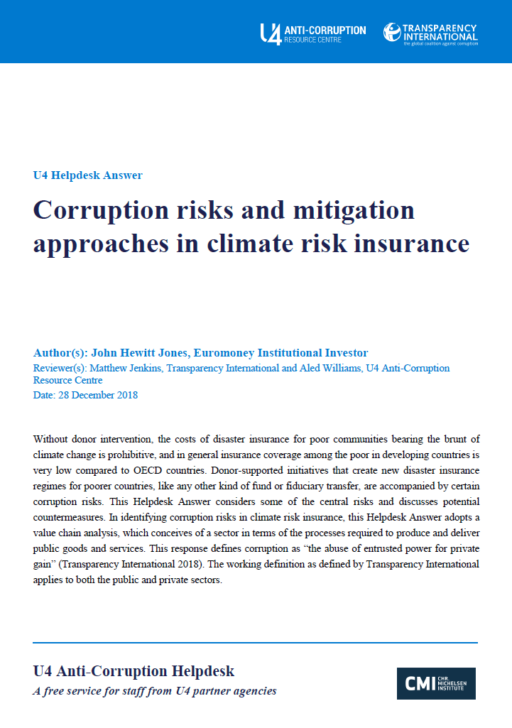
This Anti-Corruption Helpdesk brief was produced in response to a query from a U4 Partner Agency. The U4 Helpdesk is operated by Transparency International in collaboration with the U4 Anti-Corruption Resource Centre based at the Chr. Michelsen Institute.
Query
What evidence exists on how corruption might affect climate risk insurance schemes in the context of disaster mitigation, relief and recovery? What are good practices for effective monitoring and evaluation frameworks to ensure that transactions connected with disasters are transparent and accountable, as well as in line with the affected population's wants and needs?
Summary
Without donor intervention, the costs of disaster insurance for poor communities bearing the brunt of climate change is prohibitive, and in general insurance coverage among the poor in developing countries is very low compared to OECD countries. Donor-supported initiatives that create new disaster insurance regimes for poorer countries, like any other kind of fund or fiduciary transfer, are accompanied by certain corruption risks. This Helpdesk Answer considers some of the central risks and discusses potential countermeasures. In identifying corruption risks in climate risk insurance, this Helpdesk Answer adopts a value chain analysis, which conceives of a sector in terms of the processes required to produce and deliver public goods and services. This response defines corruption as “the abuse of entrusted power for private gain” (Transparency International 2018).
Main points
- Value chain analysis is a useful way to map corruption risks at sector level (Campos and Pradhan 2007).
- Risks can be characterised according to whether they occur at the stages of policymaking, organisational resources or client interface along the value chain (Transparency International 2017).
- To gain meaningful insights, it is necessary to go beyond high-level mapping of corruption risks and conduct bespoke appraisals of different sectoral value chains.
- Key remedies for corruption risks associated with this type of finance include greater claims disclosure, simpler contracts and an increase in civil engagement.
Contents
- Climate risk insurance
- Monitoring and evaluation frameworks
- Corruption risks in climate risk insurance
- Corruption mitigation in climate risk insurance
- Concluding remarks
- References
Caveat
This Helpdesk Answer does not attempt to provide a comprehensive list of all potential corruption risks in climate risk insurance schemes. Instead, it identifies and describes predictable risks based on the known general types of corruption.
The exact drivers, forms and modus operandi of corruption depends on a range of variables, including country context, institutional setting and working practices. Corruption risks of specific insurance schemes may only be identified with the help of a thorough corruption risk assessment of each individual scheme, which goes beyond the scope of this Helpdesk Answer.
Authors
John Hewitt Jones
Reviewers
Matthew Jenkins, Transparency International and Aled Williams, U4 Anti-Corruption Resource Centre
Date
20/03/2019
Tags
 Download PDF
Download PDF
